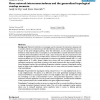Free Online Productivity Tools
i2Speak
i2Symbol
i2OCR
iTex2Img
iWeb2Print
iWeb2Shot
i2Type
iPdf2Split
iPdf2Merge
i2Bopomofo
i2Arabic
i2Style
i2Image
i2PDF
iLatex2Rtf
Sci2ools
BMCBI
2007
2007
Gene network interconnectedness and the generalized topological overlap measure
Background: Network methods are increasingly used to represent the interactions of genes and/ or proteins. Genes or proteins that are directly linked may have a similar biological function or may be part of the same biological pathway. Since the information on the connection (adjacency) between 2 nodes may be noisy or incomplete, it can be desirable to consider alternative measures of pairwise interconnectedness. Here we study a class of measures that are proportional to the number of neighbors that a pair of nodes share in common. For example, the topological overlap measure by Ravasz et al. [1] can be interpreted as a measure of agreement between the m = 1 step neighborhoods of 2 nodes. Several studies have shown that two proteins having a higher topological overlap are more likely to belong to the same functional class than proteins having a lower topological overlap. Here we address the question whether a measure of topological overlap based on higher-order neighborhoods could giv...
| Added | 09 Dec 2010 |
| Updated | 09 Dec 2010 |
| Type | Journal |
| Year | 2007 |
| Where | BMCBI |
| Authors | Andy M. Yip, Steve Horvath |
Comments (0)

